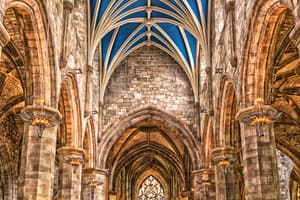Edinburgh is well known for its vibrant history, cultural traditions & tourist attractions. Indeed, Edinburgh has been awarded UNESCO World Heritage status twice over. From the cobbled and narrow streets of the medieval old town (the area where you will find The Royal Mile, Grassmarket and Edinburgh Castle) to the grandure of the Georgian New Town , the architecture of Edinburgh illustrates how the passage of time has affected the appearance of the city.
Holyrood Abbey Edinburgh consisted of the Old Town until the late 18th century. However, a growing population of over 35,000 meant that Edinburgh’s citizens, rich and poor, were living in cramped conditions. To escape this type of living, those who could afford it left for London. City officials wanted to curb this emigration and a competition was launched. The winner, James Craig became the designer of The New Town. Construction began in 1767 and was complete by 1810.
In the second half of the 18th century, Edinburgh was the centre of The Enlightenment and was home to a large number of eminent thinkers and scientists, including David Hume, James Watt and Adam Smith from nearby Fife.
The home of literary greats such as Robert Louis Stevenson and Sir Walter Scott, Edinburgh continues to inspire the modern day writer. For example, Iain Rankin and Alexander Mcall Smith use Edinburgh as the backdrop for much of their work. Readers will delight in their descriptions of famous Edinburgh landmarks and streets!
On the political front, Edinburgh held parliament until 1707 which saw the Act of Union, in which Scotland and England joined together politically. Power moved from Edinburgh’s old parliament to London’s Westminster.
However, very recently in 2002 Scotland formed a devolved Parliament and now has control of most domestic issues. Today, the parliament sits in the distinctive new parliament building next to Holyrood Palace.

